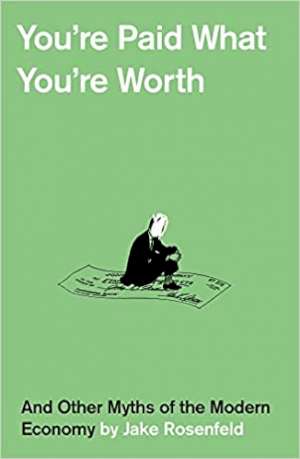08 March 2021
You're Paid What You're Worth
And Other Myths of the Modern Economy
Jake Rosenfeld
2021, Harvard University Press, 271 pages,
ISBN 9780674916593
Reviewer: Rosemary Connell

This book is largely based on US experiences and examples, with selective lessons drawn from other countries. The author challenges the often held assumptions about pay which are used to explain who gets what and why, and believes the fundamental explanations lie in struggles over interests and ideals.
The author argues that pay negotiations are influenced by power, inertia, mimicry and equity. Power is the element driving decisions legitimising pay for specific jobs. Power settles pay claims. It may be employee power via unions, coercive power by employers, shareholder power, customer power, or community power. Once the power struggle is settled, inertia may set in and pay for specific jobs becomes legitimised.
Other organisations may then mimic pay levels either vertically or horizontally, by type of service or industry or job title e.g. CEO’s who claim to be paid “the Market Rate” mimicking other CEO’s large remuneration packages.
The author describes the numerous ways in which pay is influenced by equity. One example cited is that employees may think pay cuts are unfair, so rather than adversely affect ongoing workforce morale the employer opts for redundancy.
The author then goes on to argue why the typical explanations used to explain pay levels are flawed. These include Worker Productivity and the Supply and Demand for Labour.
Despite all the literature on pay for productivity, many are not paid by this measure. Pay to reward marginal productivity is often not feasible because of the difficulties of defining or measuring individual productivity. Incentive schemes to increase sales or profitability are frequently seen to result in unacceptable results or unforeseen consequences.
Employee bargaining power can be curbed by pay secrecy, non-compete clauses in contracts, and no poaching agreements. Some US states have pay transparency laws but most do not. By contrast Norway publishes all tax returns.
The author describes (with well-chosen examples), the history of pay battles starting with the role of “the reward of merit” then to a focus on low pay (e.g. Walmart) to “shareholder first” to a focused ranking, customers, employees, community, shareholders, and then back to shareholders first with shareholder pressure to get the best return for their investment leading to the short-termism of today. Stock options are often granted to top management whose pay (especially that of CEO’s) soared increasing the gap between workers and top management. Golden Parachutes enhanced the gap.
Private Equity, an extreme example of the shareholder value model viewing companies as assets to be bought and sold to maximise profits, can work for some parties but in a number of cases leads to job losses and unpayable debts.
Deregulations can lead to increased competition followed by bankruptcies and increased industry consolidation moving power from the buyer to the seller. This may result in depressing wages unless there is countervailing union power.
Both Obama and Trump made much of bringing manufacturing jobs back to the USA. Companies were relocating jobs back to the USA anyway due to rising wages in overseas countries and de-unionisation and automation in USA. This led to a downward pressure on wages allowing companies that are not unionised e.g. Tesla to pay badly. “Temp” workers and a subcontracted workforce allow employers to reduce benefits making jobs in manufacturing less attractive.
Currently low paid occupations include retail, fast food, sanitation and ‘home’ health care. In these areas many of the jobs require minimal educational qualifications and have low margins. Franchising is rife, and labour costs are a high percentage of total costs so major savings in other areas has little effect on total costs. Worker bargaining power is therefore limited. However in, for example, Denmark some fast food workers are relatively well paid, the extra costs being absorbed in lower profits and reduced training costs due to lower employee turnover.
Pay inequality has increased in a number of countries including the USA, the main causes being power moving from employees to shareholders and employers. The author proposes a number of solutions aimed at fairer pay. These include raising the minimum wage, lowering the ceiling, and expanding the middle areas of pay grade. None of these solutions are straightforward to implement. However for example, Australian Wage Standards Boards have helped to reduce inequality. Raising top tax rates and having workers on boards can also have an effect.
The pandemic has meant that some occupations including healthcare, grocery and other key workers have received recognition and appreciation for their services. The author recommends that policies be put in place to provide living wages for the low-paid. The policy recommendations and analyses of labour market forces will certainly be different by country and are therefore not applicable universally.
Much of the book was written before the pandemic. Given the very different impacts the pandemic will have on specific industries and countries it is tricky to foresee how forces will play out in the future but the author has provided a valuable framework for viewing the way forward.
